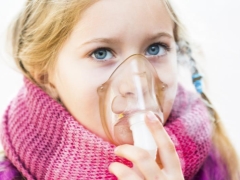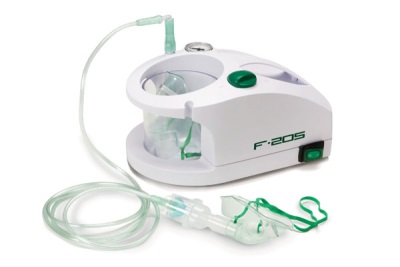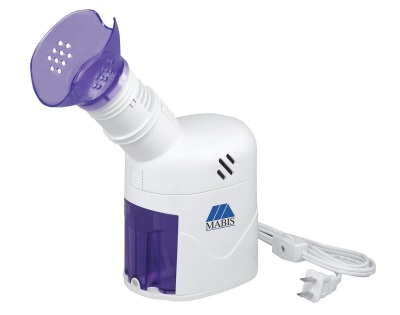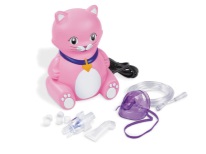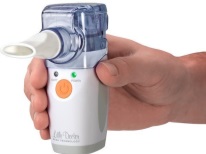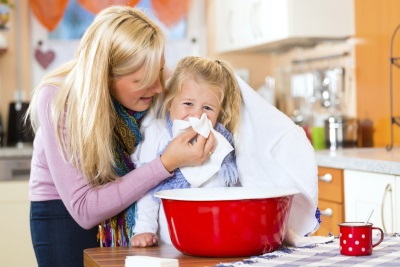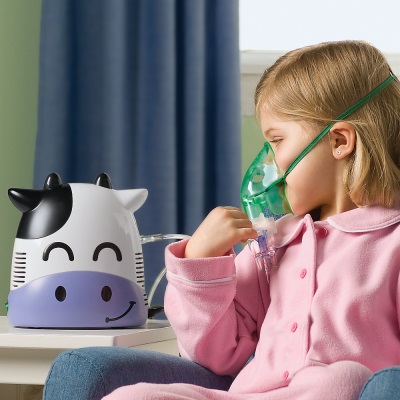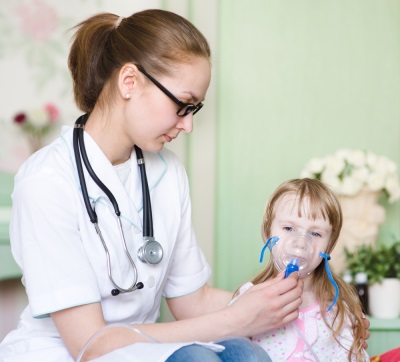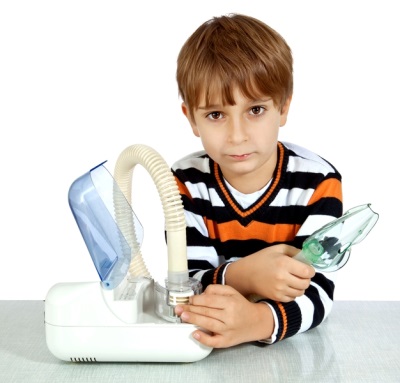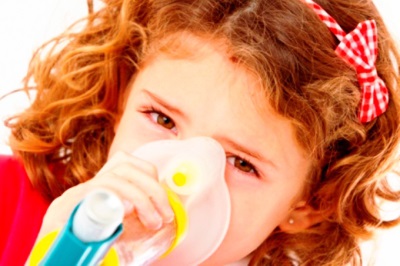Inhalers and nebulizers for children from cough and rhinitis
All parents experience acute respiratory infections in children. The smaller the baby, the harder it is for him to suffer cough, sore neck and runny nose. And quite naturally, the desire of parents to quickly help their child.
One of the ways to treat colds and SARS is called inhalation. Are they effective at cough and cough, what they are, with what devices you can make them and how exactly to carry out a medical procedure?
Types of inhalers
The name "inhaler" refers to a large group of devices used for inhalation for therapeutic or prophylactic purposes. All inhalers, depending on the type of therapeutic action are divided into steam and nebulizers.
In turn, nebulizers based on the spraying mechanism are divided into:
- compressor (drug is sprayed by the compressor);
- ultrasound (drugs go into aerosol under the action of ultrasonic waves);
- mesh (a special membrane is involved in the formation of the aerosol).
Types of inhalation
If we take into account the temperature of substances entering the respiratory system of the child, then all inhalations can be divided into:
- Cold drugs have a room temperature (up to + 30 °) and are not heated.
- Hot - drugs heat up and get into the airways in the form of heated steam.
Depending on the device used for inhalation, the procedures are divided into:
- Wet steam - they are carried out both with the use of a container with boiling water, and with the help of a steam inhaler. For such procedures, use only those drugs that do not collapse when heated. This is mainly salt, soda, medicinal herbs, and essential oils.
- Nebulizer - for such procedures need a nebulizer. These procedures are considered more effective than steam because they allow you to enter many drugs, while standing up in a certain part of the respiratory system. In addition, nebulizing inhalation is safer (there is no risk of getting burned).
Why are they effective?
The main positive effects of the use of inhalers for cough and rhinitis:
|
With a cold |
When coughing |
|
Vascular dilation and increased local immunity |
Sputum softening and relief of expectoration |
|
Increased mucus production and its antiseptic effect on pathogenic flora in the nasal cavity |
Stimulation of mucus secretion, which eliminates dry cough and prevents further spread of infection |
|
Reduction of puffiness of the mucous membrane |
Removal of dead leukocytes and bacteria from the respiratory tract |
|
Reducing the risk of complications |
|
Inhaling water vapor from a steam inhaler, the child will more effectively cope with respiratory diseases, as this will improve the production and separation of mucus, increase blood flow in the capillaries and activate metabolic processes in the mucous membranes.
The action of the nebulizer is also aimed at the transformation of drugs in liquid form into tiny particles, which are evenly distributed in the respiratory tract of the child. Depending on the size of these particles, inhalation will be a medical procedure for different parts of the respiratory tract. Thanks to this type of inhaler, drugs will quickly get into the respiratory system and will function more efficiently and longer.
Indications
Inhalation is recommended for cough and / or cold, if they are symptoms:
- ARVI;
- Acute and chronic bronchitis;
- Bronchial asthma;
- Rhinitis, laryngitis, tracheitis, pharyngitis, sinusitis and tonsillitis, which appeared as a result of exacerbation of chronic illness or cold;
- The recovery period after pneumonia;
- Fungal respiratory diseases;
- Cystic fibrosis;
- Tuberculosis.
For information on what diseases should be inhaled to a child, see the transfer of Dr. Komarovsky.
Contraindications
Inhalation is not carried out:
- in early childhood (children younger than a year);
- with otitis media;
- with bacterial tonsillitis;
- with an increase in body temperature more than + 37 ° C;
- if blood or pus is found in the sputum;
- with a tendency to bleeding from the nose;
- with intolerance to the drug used;
- in case of severe heart disease and severe respiratory failure.
In addition, it is important to know that it is forbidden to pour oil solutions into the nebulizer, since penetration of suspended oil particles into the respiratory tract of a child causes a blockage of the bronchi. The child develops pneumonia, which is very difficult to treat.
How to do the procedure?
Inhalation is carried out mainly in a sitting or standing position (only some models of the nebulizer can be used for a bed patient). If you use a steam inhaler, for the procedure take clean water or saline. The temperature of the heated water for the procedure should not exceed + 60 ° C.
Using a nebulizer for inhalation, the drug is first dissolved in the required volume of saline solution, and then poured into the device chamber, not forgetting the residual volume. In this case, the drug should always be fresh, and the saline solution - sterile. It is necessary to refill medicine in the nebulizer with a sterile syringe.
The average duration of inhalation is from 5 to 10 minutes. After that, the child should rinse the face and mouth with clean water. Drinking and eating is recommended not earlier than half an hour after the procedure.
What medications are added to the inhaler and which solutions are effective?
When coughing and running nose for inhalation, use of such substances:
Group of drugs | What means to it include | How to act | What help |
Mucous moisturizers | Salty water Mineral water Saline Soda solution | Softens the mucous membrane | Dry cough Barking cough |
Bronchodilators | Berotek | Eliminate spasms in the airways | Dry cough Barking cough Allergic cough |
Mucolytics | Lasolvan | Contribute to the dilution and sputum | Dry cough Moist cough |
Anti-inflammatory | Pulmicort Budesonide Rotokan | Reduce inflammation and relieve swelling | Barking cough Allergic cough Moist cough |
Tussamag Lidocaine | Suppress strong cough | Barking cough | |
Medicinal herbs | Chamomile Linden flowers Leaves cowberry Thyme Coltsfoot Juniper Mint Raspberry leaves Hypericum | They have anti-inflammatory, mucolytic and soothing effects. | Dry cough |
Furacilin Chlorophyllipt | Clear mucous membranes | Barking cough Moist cough | |
Essential oils | Mint Almond Sea buckthorn Pines Peach Eucalyptus | They have anti-inflammatory and emollient effects. | Dry cough |
In addition to these groups, a child with a cough can be given inhalations based on antibiotics, enzymes or immunostimulants. In any case, the selection of drugs for inhalation should be carried out by a doctor. It is permissible for children to inhale themselves only with the use of moisturizing agents (water with salt, soda, mineral water).
What parameters to pay attention to when choosing?
When choosing an inhaler for treating children from diseases of the respiratory system, first of all decide on the type of device, since each of them has its own advantages. For a compressor nebulizer, this is a low price and ease of use, for ultrasound it is quiet and compact, and the mesh device is considered the highest quality and most convenient.
In addition, each has its drawbacks, for example, the compressor apparatus is very noisy and bulky, the mesh nebulizer is very expensive, and in an ultrasound device some drugs are destroyed. The steam inhaler is cheaper, but can only be used for uncomplicated diseases and is not recommended for the treatment of preschool children.
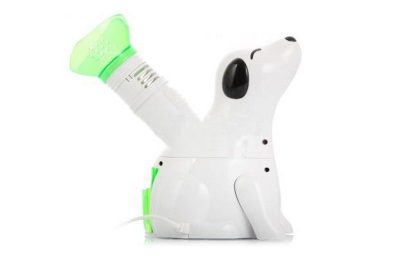
In addition, choosing a nebulizer child, consider:
- the capacity of its reservoir (how much drug will fit into the device);
- device performance (how much aerosol is produced in one minute);
- residual volume (how much unused medicine remains).
So that the child is not afraid of the device, he can get a nebulizer in the form of a bright interesting toy. Such devices blink and make sounds, making the procedure look like a game.
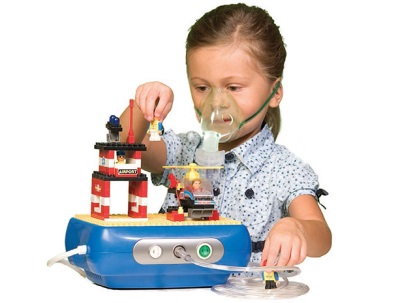
Opinion E. Komarovsky
Famous pediatrician emphasizes that inhalation are not the main treatment for cough and runny nose, and if you do not water the baby and do not optimize the temperature and humidity in the room, the effectiveness of inhalation will be very low. With regard to the choice of inhaler, then with the defeat of the upper respiratory tract Komarovsky advises to use a steam inhaler.
If a child has illnesses of the lower respiratory system, which are often serious diseases, the popular doctor, though, points out that in this case you should use nebulizer, but at the same time reminds that self-medication can harm. According to Komarovsky, the nebulizer should be bought and used only after consulting with a pediatrician.
Regarding steam inhalations, a well-known doctor recalls that the main effect of the procedure is the moistening of sputum and the enhancement of its expectoration. As a result, the volume of mucus increases, so inhalation can provoke obstruction. If there is no dried mucus in the airways, according to Komarovsky, the child does not need inhalations.
Tips on choosing an inhaler Dr. Komarovsky gives in the next video.
Tips
- Inhalation should not be carried out after a meal for at least 60-90 minutes. Also, make sure that the child does not talk during the procedure.
- Treatment and rhinitis, and cough is carried out with an inhaler using a mask. If a child has a runny nose, breathing should be through the nose and rather deep. When coughing, inhale and exhale the medicine or steam through the mouth.
- Inhalation, which is carried out before bedtime, is most effective.
- Do not pour herbal decoction into the nebulizer, as this may cause clogging and damage to the mechanism in the device.
- A child under 6 years old should not be given medicines by inhalers without consulting a doctor.
Reviews
The most practical device among inhalers parents call compressor nebulizers, since they can be used not only in childhood, but also for adult family members. Buyers are attracted by their effectiveness in coughing and coryza, as well as ease of use, and among the downsides is most often called noisy work.
Also, many positive reviews noted in the mesh nebulizers, but the high price limits the use of such devices for SARS in children. Basically, such a nebulizer is bought for serious diseases, such as bronchial asthma or obstructive bronchitis.
You can learn about the intricacies of using inhalers by looking at the video of the Union of Pediatricians of Russia.
